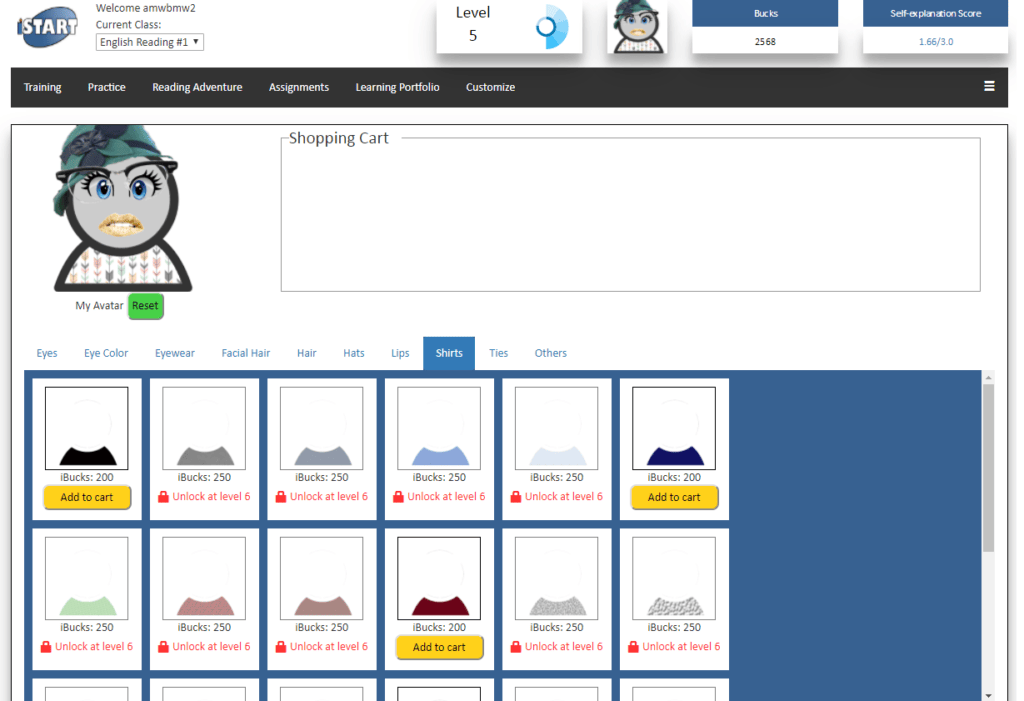iSTART: Interactive Strategy Training for Active Reading and Thinking
Danielle S. McNamara, PhD, Principal Investigator
Literacy is a central aspect of modern society. Unfortunately, many readers lack the skills necessary to obtain knowledge from texts and particularly from textbooks (NAEP, 2000). Fortunately, skills can be acquired through instruction in the use of reading strategies that enhance students’ ability to understand challenging material, such as science content.
The interactive Strategy Training for Active Reading and Thinking (iSTART) project centers on processes that tend to result in deeper understanding of scientific concepts, including the pivotal notion of self-explanation (Chi, de Leewu, Chiu, & LaVancher, 1994; McNamara, 2004; Van Lehn, Jones, & Chi, 1992). Students who self-explain texts are more successful at solving problems, more likely to generate inferences, construct more coherent mental models, and develop a deeper understanding of the concepts covered in the text. However, not all students are able to successfully self-explain text. They either lack the reading skills or prior domain knowledge to do so. The iSTART system was developed to provide instruction in reading strategies that support the process of self-explanation. The current effort furthers previous work on iSTART by examining whether a gaming environment for learning self-explanation and reading strategies to understand science texts sustains students’ attention and engagement during training, and by consequence, improves learning of the strategies.
The main goal of the iSTART-ME (Motivationally Enhanced) project is to implement several game-based principles and features that are expected to support effective learning, increase motivation, and sustain engagement throughout a long-term interaction with an established Intelligent Tutoring System (ITS). This goal is achieved through four phases of interactive tutoring: Introduction, Demonstration, Initial Practice, and Extended Practice.
The first three phases (Introduction, Demonstration, and Initial Practice) were designed as the core training components and can be completed within 2 hours. The fourth phase (Extended Practice) was designed to help students master the strategies by providing a long-term practice environment that can span across weeks or months. The Introduction module contains three animated agents that engage in a vicarious dialogue to introduce the concept of self-explanation and each of the five iSTART reading strategies (comprehension monitoring, prediction, paraphrasing, elaboration, and bridging). The Demonstration module includes two agents who generate and discuss the quality of example self-explanations. The Initial Practice module requires learners to generate their own self-explanations and an animated agent provides qualitative feedback on how to improve the self-explanation quality. The Extended Practice environment continues this generative practice over a longer time period and allows teachers to assign specific texts. This long-term practice is necessary for skill mastery, but it can often lead to disengagement. Thus, iSTART-ME (motivationally enhanced) has been developed on top of the existing ITS and incorporates many game-based elements.


Previous versions of the iSTART extended practice module automatically progressed students from one text to another with no intervening actions. The new version of iSTART-ME is controlled through a selection menu. This menu provides students opportunities to interact with new texts, earn points, advance through levels, purchase rewards, personalize a character, and play educational mini-games.

The selection menu includes a suite of eight educational mini-games, designed to use the same strategies as in practice. Some mini-games require identification of the type of strategy use, while others may require students to generate their own self-explanations. The majority of iSTART mini-games require similar cognitive processes enveloped within different combinations of gaming elements. For example, in Balloon Bust students are presented with a target sentence and an example self-explanation. The student must decide which iSTART strategy was used in the self-explanation and then click on the corresponding balloons. There are also three other mini-games which focus on the same task of identifying strategies within example self-explanations. These other games each incorporate a new interface with a different combination of game elements, including fantasy, competition, and perceptual aspects (as in Balloon Bust). Though the surface features of these games can differ widely, they have been designed with very similar leveling structures and can all be completed within 10-20 minutes.


Several studies with iSTART and iSTART-ME have indicated significantly positive outcomes for students. Users of the systems have demonstrated significant increases in both knowledge and performance during and after tutoring. Recent evaluations have focused on the complex interactions between motivation, engagement, and learning that stem from participants’ use of the iSTART-ME selection menu over longer periods of time (many separate sessions spanning across several weeks).